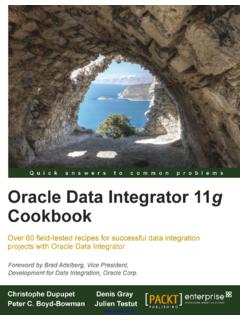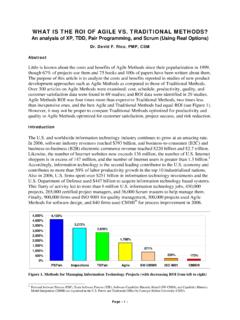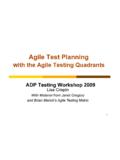Transcription of This document was created by an unregistered …
1 Agile Project Management with Scrumby Ken Schwaber ISBN:073561993xMicrosoft Press 2004 Apply the principles of Scrum, one of the most popular agile programming methods, to software project management and focus your team on delivering realbusiness of Contents Agile Project Management with ScrumForewordIntroductionChapter 1-Backdrop: The Science of ScrumChapter 2-New Management ResponsibilitiesChapter 3-The ScrumMasterChapter 4-Bringing Order from ChaosChapter 5-The Product OwnerChapter 6-Planning a Scrum ProjectChapter 7-Project Reporting Keeping Everything VisibleChapter 8-The TeamChapter 9-Scaling Projects Using ScrumAppendix A-RulesAppendix B-DefinitionsAppendix C-ResourcesAppendix D-Fixed-Price, Fixed-Date ContractsAppendix E-Capability Maturity Model (CMM)IndexThis document was created by an unregistered chmmagic , please go to to register it.
2 Of FiguresThis document was created by an unregistered chmmagic , please go to to register it. Thanks. Back CoverThe rules and practices for Scrum a simple process for managing complex projects are few, straightforward, and easy to learn. But, Scrum s simplicity itself its lack of prescription canbe disarming, and new practitioners often find themselves reverting to old project management habits and tools and yielding lesser results. In this illuminating series of case studies, Scrumco-creator and evangelist Ken Schwaber identifies the real-world lessons the successes and failures culled from his years of experience coaching companies in agile projectmanagement. Through them, you ll understand how to use Scrum to solve complex problems and drive better results delivering more valuable software the foundation in Scrum theory and practice you need to.
3 Rein in even the most complex, unwieldy projectsEffectively manage unknown or changing product requirementsSimplify the chain of command with self-managing development teamsReceive clearer specifications and feedback from customersGreatly reduce project planning time and required toolsBuild and release products in 30-day cycles so clients get deliverables earlierAvoid missteps by regularly inspecting, reporting on, and fine-tuning projectsSupport multiple teams working on a large-scale project from many geographic locationsMaximize return on investment!About the Author Ken Schwaber codeveloped the Scrum process with Jeff Sutherland in the early 1990s to help organizations struggling with complex development projects.
4 One of the signatories to the Agile Manifesto in 2001, he subsequently founded the AgileAlliance, a nonprofit organization dedicated to the creation of agile software, and currently serves as its chairman of the board. A 30-year veteran of the software development industry, he teaches and speaks at numerous conferences, including OOPSLA and Software Development. This document was created by an unregistered chmmagic , please go to to register it. Thanks. Agile Project Management with ScrumKen Schwaber PUBLISHED BY Microsoft Press A Division of Microsoft Corporation One Microsoft Way Redmond, Washington 98052-6399 Copyright 2004 by Ken SchwaberAll rights reserved. No part of the contents of this book may be reproduced or transmitted in any form or by any means without the written permission of the publisher.
5 Library of Congress Cataloging-in-Publication Data Schwaber, Ken. Agile Project Management with Scrum / Ken Schwaber. p. cm. Includes index. ISBN 0-7356-1993-X 1. Computer software--Development. 2. Project management. 3. Scrum (Computer software development) I. Title. 2003 2003065178 Printed and bound in the United States of America. 1 2 3 4 5 6 7 8 9 QWE 8 7 6 5 4 3 Distributed in Canada by Fenn and Company Ltd. A CIP catalogue record for this book is available from the British Library. Microsoft Press books are available through booksellers and distributors worldwide. For further information about international editions, contact your local Microsoft Corporation office or contact Microsoft Press International directly at fax (425) 936-7329.
6 Visit our Web site at Send comments to Microsoft and Microsoft Press are either registered trademarks or trademarks of Microsoft Corporation in the United States and/or other countries. Other product and company names This document was created by an unregistered chmmagic , please go to to register it. herein may be the trademarks of their respective owners. The example companies, organizations, products, domain names, e-mail addresses, logos, people, places, and events depicted herein are fictitious. No association with any real company, organization, product, domain name, e-mail address, logo, person, place, or event is intended or should be inferred. This book expresses the author s views and opinions.
7 The information contained in this book is provided without any express, statutory, or implied warranties. Neither the authors,Microsoft Corporation, nor its resellers or distributors will be held liable for any damages caused or alleged to be caused either directly or indirectly by this Editors Linda Engelman andRobin Van Steenburgh Project Editor Kathleen Atkins Indexer Bill Meyers Body Part No. X10-25679 Dedicated to ScrumMasters AcknowledgmentsSpecial thanks to my daughter, Carey Schwaber, whose editing turns words into streams, and to Mike Cohn and Mary Poppendieck, for their fine help in keeping this book focused. Ken SchwaberKen Schwaber codeveloped the Scrum process with Jeff Sutherland in the early 1990s and has used it ever since to help organizations struggling with complicated development projects.
8 One of the signatories to the Agile Manifesto in 2001, he went on to found the AgileAlliance, of which he is currently the Chairman of the Board. Ken has over thirty years of experience in the various aspects of systems development. This document was created by an unregistered chmmagic , please go to to register it. Thanks. ForewordOverviewMy new boss wasn t being a jerk, but it seemed like it at the time. We were writing new software for use in the company s high-volume call centers. Instead of the 12 months I told himwe d probably need, he had agreed to give me 4 months. We wouldn t necessarily start using the new software in 4 months, but from that point on, all my boss could give me was 30days notice of a go-live date.
9 After the first 4 months, I would have to keep the software within 30 days of releasable. My boss understood that not all functionality would be there after4 months. He just wanted as much as he could get, as fast as he could get it. I needed to find a process that would let us do this. I scoured everything I could find on softwaredevelopment processes, which led me to Scrum and to Ken Schwaber s early writings on the years since my first Scrum project, I have used Scrum on commercial products, software for internal use, consulting projects, projects with ISO 9001 requirements, and others. Each of these projects was unique, but what they had in common was urgency and criticality. Scrum excels on urgent projects that are critical to an organization.
10 Scrum excels when requirements are unknown, unknowable, or changing. Scrum excels by helping teams this book, Ken Schwaber correctly points out that Scrum is hard. It s not hard because of the things you do; it s hard because of the things you don t do. If you re a project manager,you might find some of your conventional tools missing. There are no Gantt charts in Scrum, there s no time reporting, and you don t assign tasks to programmers. Instead you ll learnthe few simple rules of Scrum and how to use its frequent inspect-and-adapt cycles to create more valuable software was there at the beginning of Scrum. Ken, along with Jeff Sutherland, was the original creator of Scrum and has always been its most vocal proponent.








